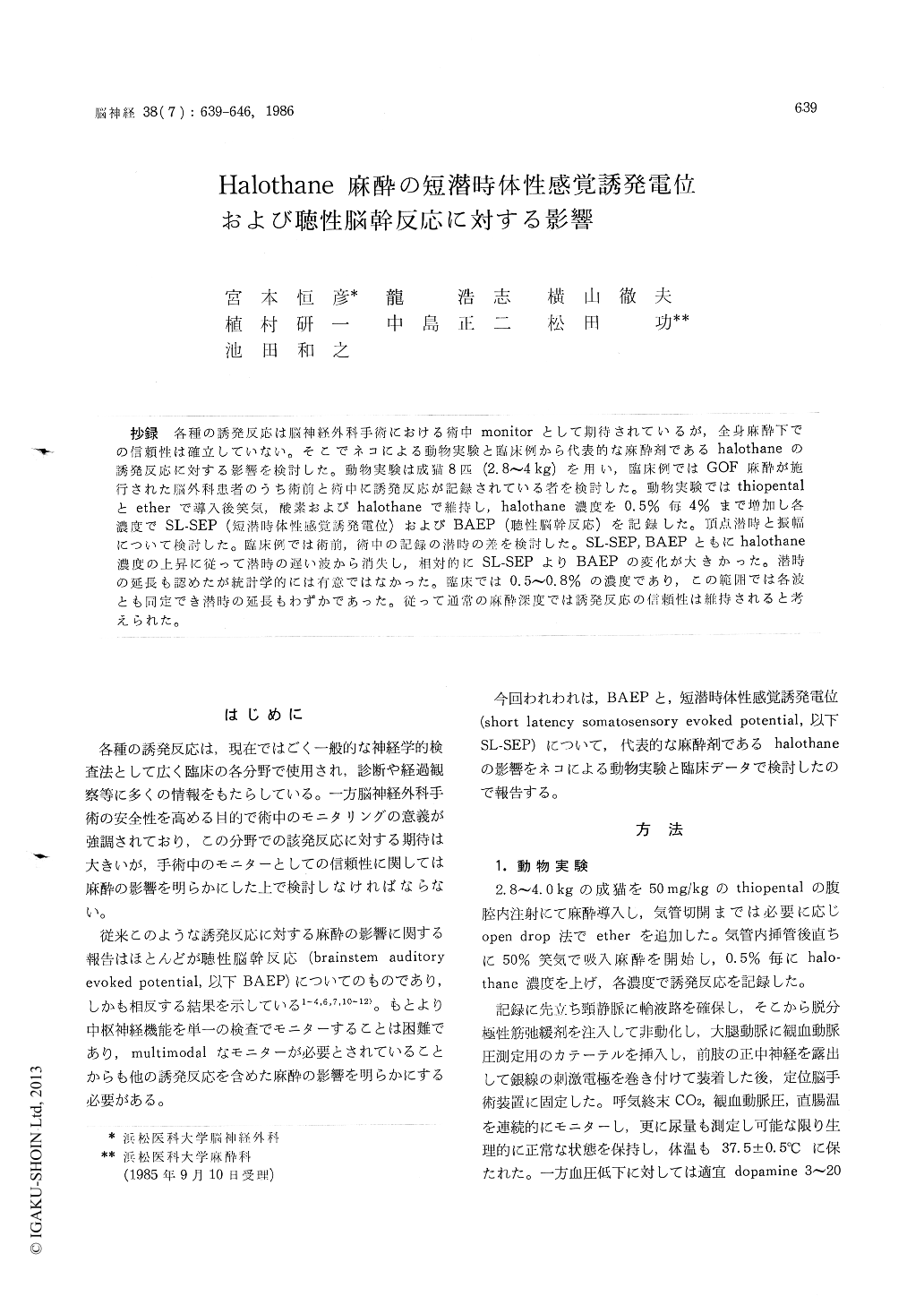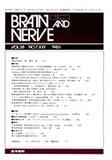Japanese
English
- 有料閲覧
- Abstract 文献概要
- 1ページ目 Look Inside
抄録 各種の誘発反応は脳神経外科手術における術中monitorとして期待されているが,全身麻酔下での信頼性は確立していない。そこでネコによる動物実験と臨床例から代表的な麻酔剤であるhalothaneの誘発反応に対する影響を検討した。動物実験は成猫8匹(2.8〜4kg)を用い,臨床例ではGOF麻酔が施行された脳外科患者のうち術前と術中に誘発反応が記録されている者を検討した。動物実験ではthiopentalとetherで導入後笑気,酸素およびhalothaneで維持し, halothane濃度を0.5%毎4%まで増加し各濃度でSL-SEP (短潜時体性感覚誘発電位)およびBAEP (聴性脳幹反応)を記録した。頂点潜時と振幅について検討した。臨床例では術前,術中の記録の潜時の差を検討した。SL-SEP, BAEPともにhalothane濃度の上昇に従って潜時の遅い波から消失し,相対的にSL-SEPよりBAEPの変化が大きかった。潜時の延長も認めたが統計学的には有意ではなかった。臨床では0.5〜0.8%の濃度であり,この範囲では各波とも同定でき潜時の延長もわずかであった。従って通常の麻酔深度では誘発反応の信頼性は維持されると考えられた。
Intraoperative monitoring of central nervous system functions is useful for safe neurosurgical operations. For such a purpose, some kinds of sensory evoked potentials play significant roles, but their reliability during general anesthesia have not yet been established. The authors conduct-ed experimental and clinical studies to reveal effects of halothane, a most popular anesthetic, on sensory evoked potentials.
Eight adult cats, weighing 2.8-4.0kg, were in-duced to anesthesia with thiopental and ether, and after tracheostomy and venous cannulation, they were immobilized with succinylcholine and arti-ficially ventilated with mixture of oxygen, nitorous oxide halothane. The concentration of halothane was increased up to 4.0% by 0.5% steps. The body temperature, systemic blood pressure and carbon dioxide concentrations in expires gas were moni-tored continuously, and maintained within normal ranges as much as possible. The hypotension indu-ced by halothane was easily corrected by dopa-mine infusion initially, but later became difficult to be controlled as the halothane concentration increased.
In each concentration, short latency somatosen-sory evoked potentials by median nerve stimula-tions (SL-SEP), and brain stem auditory evoked potentials (BAEP) were recorded. Active electrode was placed on the bregma, and reference electrodes were placed on a hindlimb for SL-SEP, on the tongue for BAEP recordings.
Peak amplitudes of SL-SEP were gradually de-creased and finally disappeared without apparent dose dependency. Relatively the peaks with long-er latencies were more affected than those with shorter latency such as P1 and N 1.
In BAEP, decrement of the amplitude was appa-rent in the peaks with longer latencies with an obvious dose dependency. All the peaks were easily identified below 1.0% of halothane, but P 5 had disappeared at 1.5% and P4 became obscure at 2.0%.
Peak latencies of SL-SEP prolonged as the ha-lothane concentration increased particularly more so with longer peak latencies. However, due to limited sample numbers, these changes were not statistically significant except in very high con-centration states (more than 3.0%).
BAEP showed almost the same patterns but lesser significance because of rapid disappearance of later peaks.
Clinically, patients operated under GOF anesthe-sia with both pre- and intraoperative recordings were reviewed. During their operations the con-centration of halothane varied 0.5 to 0.8%. Un-der these conditions, the halothane little changed peak amplitudes, so all peaks were easily identi-fied. And almost all peaks prolonged a little.
It is supposed that anesthetics affect on synap-tic transmissions, and if so, it is reasonable that BAEP is more sensitive to the anesthetics. Be-cause the auditory system has more synapses than the somatosensory system.
In conclusion, SL-SEP and BAEP have sufficient reliability during general anesthesia, so far as the halothane is used in conventional doses.

Copyright © 1986, Igaku-Shoin Ltd. All rights reserved.


